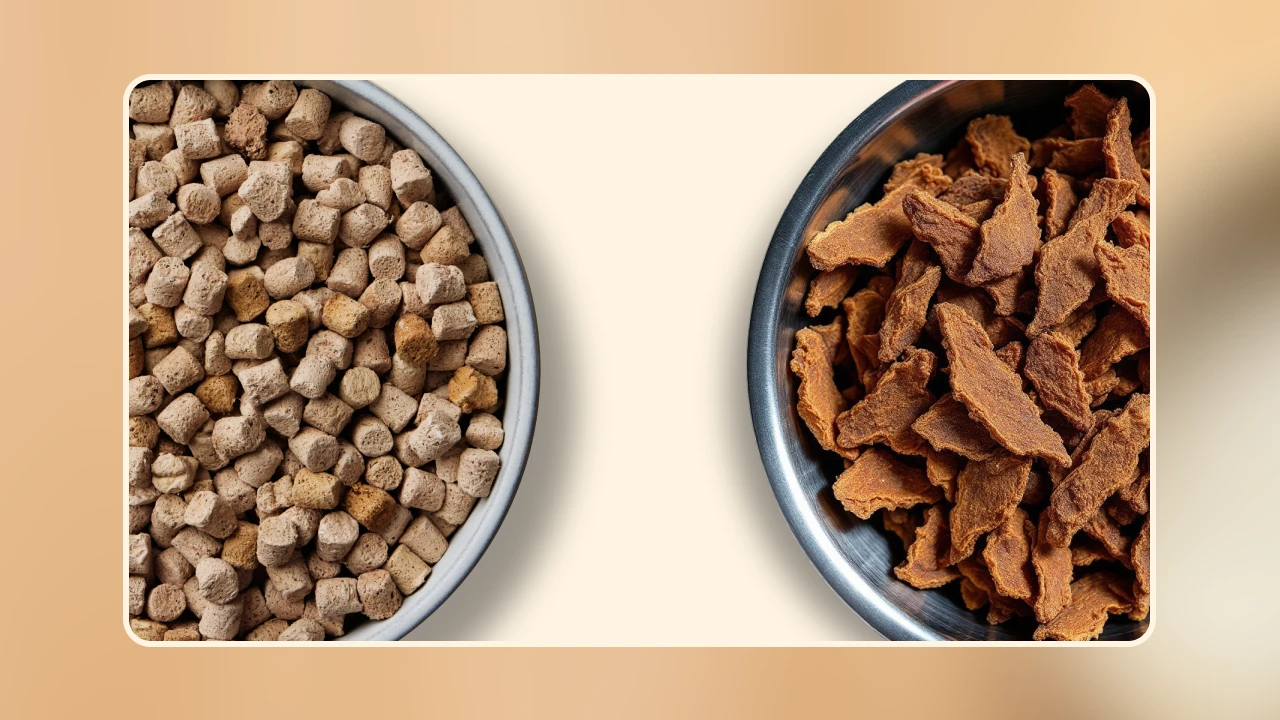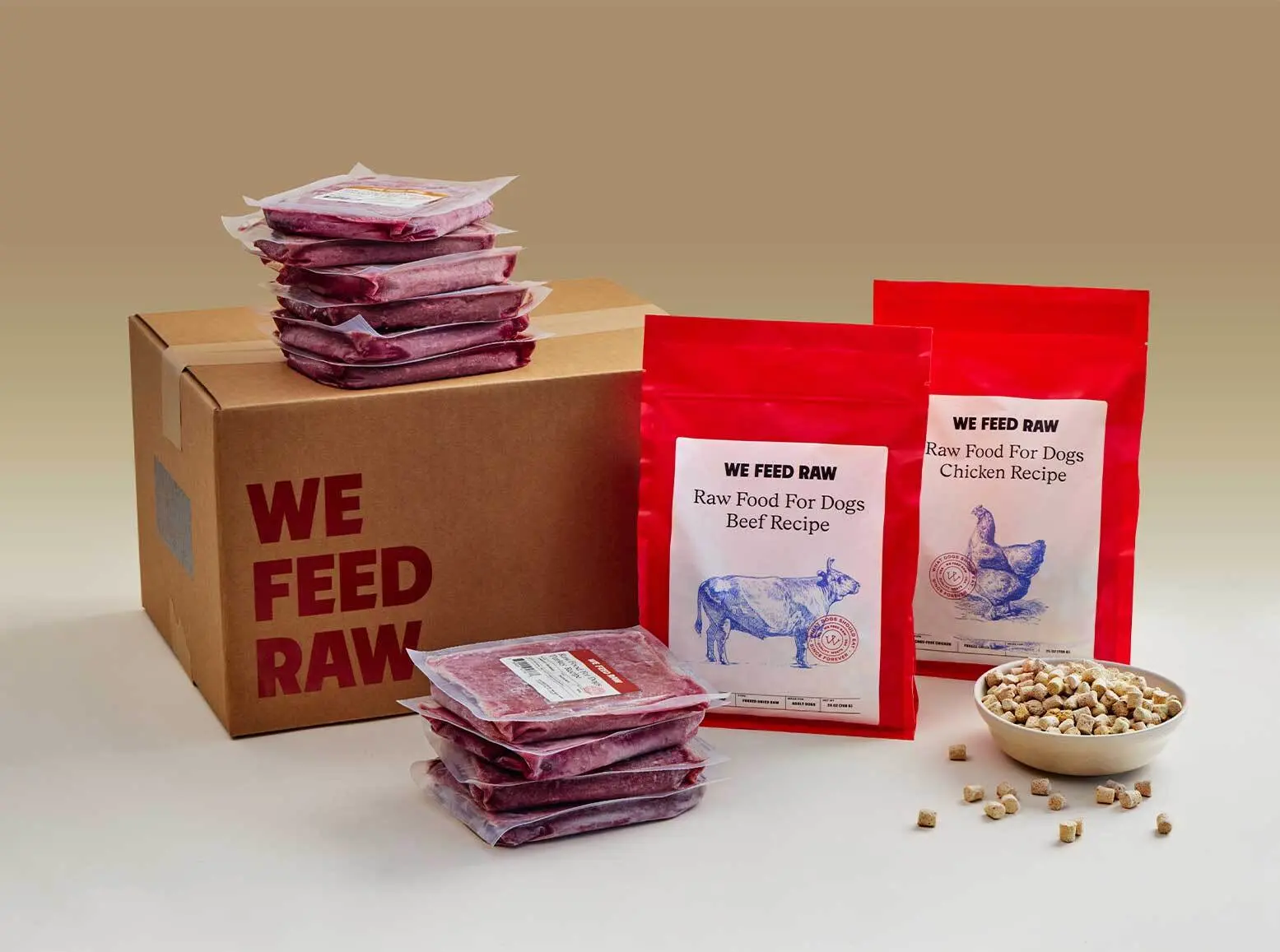
Air-Dried vs. Freeze-Dried Dog Food: Key Differences & Benefits Explained
Choosing the healthiest dog food for your beloved companion often leads to exploring options beyond traditional kibble. Air-dried and freeze-dried dog foods have gained popularity as convenient ways to provide a diet closer to raw, but they aren't created equal.
This guide will compare air-dried vs. freeze-dried dog food, examining their processes, nutritional benefits, and overall value to help you understand which method truly excels at preserving the wholesome goodness of raw ingredients for your dog.
Understanding the Basics: What Is Air-Dried Dog Food?
Air-dried dog food has emerged as a popular alternative for pet parents seeking less processed options than conventional kibble. It offers a convenient, shelf-stable way to feed ingredients that have undergone a gentler form of preservation.
But what exactly does the air-drying process entail, and what are its key characteristics?
The Air-Drying Process: Gentle Dehydration Explained
The air-drying process for dog food involves slowly and gently removing moisture from raw ingredients using low-temperature, circulating air.
This method is distinct from high-heat cooking or extrusion used for kibble. By gradually evaporating the water content over an extended period, the food is preserved naturally, inhibiting the growth of bacteria and mold.
The aim is to reduce moisture significantly while retaining more of the natural goodness of the ingredients compared to high-heat methods.
Key Characteristics: Texture, Moisture Content, and Nutrient Retention
Air-dried dog food typically has a jerky-like texture, which can range from somewhat pliable to quite firm and chewy, depending on the specific product and ingredients. The moisture content is considerably reduced, making it shelf-stable without the need for artificial preservatives.
Regarding nutrient retention, air-drying is gentler than high-heat processing, so it does preserve a good portion of the original nutrients. However, the prolonged exposure to air and even low levels of heat can still lead to some degradation of heat-sensitive vitamins and enzymes over the extended drying period.
While an improvement over conventional methods, it may not preserve the full spectrum of delicate nutrients as effectively as some other minimal-processing techniques.
Is Air-Dried Considered Raw?
Generally, air-dried dog food is often marketed and considered to be a "close-to-raw" food because it avoids the high temperatures associated with cooking. The process aims to keep the ingredients in a state that's nutritionally closer to their original raw form.
However, it's worth noting that the extended drying time and exposure to air mean it undergoes more alteration than food preserved through methods like freeze-drying, which more comprehensively locks in raw nutrients.
Understanding the Basics: What Is Freeze-Dried Dog Food?
Freeze-dried dog food represents a premium choice for pet parents committed to providing the nutritional power of raw ingredients with maximum convenience and safety. This innovative approach to food preservation is widely regarded for its exceptional ability to lock in nutrients and maintain the natural integrity of the food.
The Freeze-Drying Process: Sublimation for Preservation
The magic of freeze-drying lies in a sophisticated three-step process called sublimation.
First, the raw ingredients are rapidly frozen at very low temperatures. Then, the frozen food is placed in a vacuum chamber where the air pressure is significantly lowered. In this environment, the ice crystals in the food transform directly into water vapor, bypassing the liquid stage entirely.
Finally, a secondary drying phase removes any remaining bound water molecules. This meticulous process is a gold standard for preservation because it removes water without significantly altering the food's structure, taste, or, most importantly, its nutritional profile.
Key Characteristics: Lightweight, Long Shelf Life, and Rehydration
One of the standout features of freeze-dried dog food is its incredibly lightweight nature, as nearly all the water content (which is heavy) has been removed. This makes it easy to store, handle, and transport.
It also boasts an impressively long shelf life without the need for artificial preservatives, thanks to the extremely low moisture content that inhibits bacterial growth.
Due to the gentle nature of freeze-drying, it retains an exceptionally high percentage of the original vitamins, minerals, enzymes, and other vital nutrients.
Is Freeze-Dried Considered Raw?
Absolutely. Freeze-dried dog food is unequivocally considered raw. The entire process occurs at low temperatures, ensuring that the ingredients are never cooked or exposed to heat that would denature proteins or significantly diminish the nutrient content.
At We Feed Raw, we champion freeze-drying for our recipes precisely because it allows us to deliver food that maintains the powerful benefits of its original raw state.
This method preserves the delicate balance of amino acids, vital enzymes, and essential nutrients that make raw feeding so beneficial for a dog's health, digestion, and vitality.
Head-to-Head Comparison: Air-Dried vs. Freeze-Dried Dog Food
Now that we understand the basics of air-dried and freeze-dried dog foods, let's put them side-by-side. While both offer an upgrade from highly processed kibble, a closer look reveals significant differences that can impact everything from nutritional value to mealtime excitement for your dog.
Manufacturing & Nutrient Integrity
This is where the most significant distinctions lie:
•Air-Dried: Uses low-temperature circulating air over an extended period to dehydrate food. While gentler than high-heat cooking, this prolonged exposure to air (and potential for some heat) can still lead to a notable degradation of heat-sensitive vitamins, enzymes, and antioxidants. The food's cellular structure can also be somewhat compromised.
•Freeze-Dried: Employs a sophisticated sublimation process (freezing, then vacuum-drying to turn ice directly to vapor). This method is exceptionally gentle, occurring at very low temperatures and without the oxidative stress of prolonged air exposure.
Winner: Freeze-Dried. It overwhelmingly excels at preserving the original nutritional integrity of raw ingredients, keeping vitamins, minerals, and crucial enzymes virtually intact, far closer to their natural state.
Cost Considerations
Here’s what to expect price-wise for each option:
•Air-Dried: Generally, air-dried foods can be slightly less expensive than freeze-dried options due to a less complex and energy-intensive manufacturing process.
•Freeze-Dried: The meticulous freeze-drying process is more technologically advanced and time-consuming, which often translates to a higher price point. However, it's crucial to view this as an investment in superior nutrient retention and quality. Given its nutrient density, feeding amounts may also be smaller.
Winner (Value): Freeze-Dried. While potentially higher in upfront cost, the superior nutritional value and ingredient integrity delivered by freeze-drying offer greater overall value for your dog's health.
Convenience & Storage
Now, let’s compare the ease of use, shelf-stability, and portability of each option:
•Air-Dried: Offers good convenience as it's shelf-stable, doesn't require refrigeration (until opened, then per package), and is relatively easy to serve. It tends to be denser and heavier than freeze-dried.
•Freeze-Dried: Also highly convenient and shelf-stable with a long shelf life. It is exceptionally lightweight, making it ideal for travel or easy storage. A key advantage of We Feed Raw's freeze-dried food is its versatility—it can be fed dry, straight from the bag for maximum convenience, or rehydrated if preferred, offering flexibility many other brands don't.
Winner: Freeze-Dried. Its lightweight nature combined with the superior convenience of being ready-to-serve dry gives it an edge.
Dietary Flexibility & Feeding Ratios
Let’s look at typical meal quantities and how to adjust for your dog’s needs:
•Air-Dried: Is nutrient-concentrated compared to fresh food, so portion sizes are smaller than kibble. The jerky-like texture may not suit all dogs, especially those with dental sensitivities.
•Freeze-Dried: Highly concentrated in nutrients, meaning smaller portions pack a powerful nutritional punch. The ability to serve We Feed Raw's freeze-dried food as-is or rehydrated provides excellent flexibility to cater to your dog's preferences and hydration needs. Rehydration can also be beneficial for increasing water intake.
Winner: Freeze-Dried. Its nutrient density and the versatile serving options make it adaptable to various needs.
Health & Longevity Benefits
Here are some of the potential benefits for your pup:
•Air-Dried: Offers benefits over kibble by retaining more nutrients due to lower processing temperatures. This can contribute to improved digestion and overall health compared to conventional diets.
•Freeze-Dried: By preserving the highest levels of natural enzymes, amino acids, and bioavailable nutrients, freeze-dried food most closely mirrors the health benefits of a fresh raw diet. This can lead to more noticeable improvements in energy levels, skin and coat health, dental hygiene, and digestive function, contributing significantly to long-term wellbeing.
Winner: Freeze-Dried. Its superior nutrient preservation translates directly to more profound health benefits.
Mealtime Excitement & Palatability
Which food is better for picky eaters?
•Air-Dried: Can be quite palatable for many dogs due to its meaty nature. However, the texture can sometimes be very firm or dry, which might not appeal to all dogs.
•Freeze-Dried: Often exceptionally palatable due to the preservation of natural aromas and flavors from the raw ingredients. The ability to serve it dry or rehydrated to a softer, moisture-rich consistency makes it a fantastic option for even the fussiest eaters.
Winner: Freeze-Dried. The enhanced flavor retention and versatile texture options typically make it a hit.
Freeze-Dried We Feed Raw: The Future of Convenient Raw Nutrition
When it comes to providing your dog with food that's as close as possible to a fresh raw diet, but with the ease modern pet parents need, the differences between air-dried and freeze-dried options become clear.
While both offer improvements over conventional kibble, freeze-dried dog food consistently stands out for its superior nutrient retention, preservation of raw qualities, and overall nutritional power.
By choosing a high-quality freeze-dried raw food, like the recipes offered by We Feed Raw, you're not just feeding your dog; you're investing in their long-term health and vitality with a convenient, incredibly nutritious option that dogs love.
Make the switch and see the vibrant difference it can make for your furry best friend.
Frequently Asked Questions (FAQs)
What's the main difference in how air-dried vs. freeze-dried dog food is made, and why does it matter?
Air-drying slowly removes moisture with low-temperature air, which can still degrade some nutrients. Freeze-drying first freezes the food, then removes ice as vapor in a vacuum. This superior process best preserves the raw ingredients' structure and nutrient integrity, closely mimicking a fresh raw diet's benefits.
Is freeze-dried dog food generally considered better than air-dried for preserving nutrients?
Yes, freeze-drying is superior for nutrient preservation. Its use of minimal heat ensures that vital heat-sensitive vitamins and enzymes are largely retained, keeping the food much closer to its original, nutrient-rich raw state compared to air-drying.
When considering air-dried vs. freeze-dried dog food, which offers more benefits similar to a fresh raw diet?
Freeze-dried dog food more closely delivers the benefits of a fresh raw diet. It excels at preserving the bioavailability of nutrients and enzymes. Plus, most dogs prefer the texture of freeze-dried dog food over air-dried food.
Are both air-dried and freeze-dried dog foods considered "raw"?
Yes, both are considered "raw" as they avoid high-heat cooking. However, freeze-drying is widely regarded as keeping the food closest to its original raw nutritional state due to its gentle, nutrient-preserving process.
Why does We Feed Raw offer freeze-dried raw food?
We Feed Raw chooses freeze-drying because it's the best method to preserve the vital nutrients, enzymes, and taste of raw ingredients in a convenient, shelf-stable form. This ensures we provide a highly digestible, nutrient-dense food for optimal canine health, mirroring the benefits of our frozen raw diets.

Our Meals Change Lives.
(Theirs + Yours.)
See health improvements from our raw meals in as little as 1 week.
